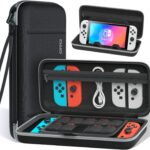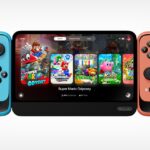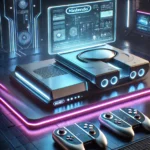What is HWFly and Why Install it on Nintendo Switch OLED?
The HWFly modchip represents a significant advancement in Nintendo Switch modding technology, specifically designed for OLED models. Unlike software-based exploits that require specific firmware versions, HWFly provides a hardware-based solution that enables custom firmware installation regardless of the system’s software version.
The HWFly modchip offers several advantages over traditional modding methods:
- Firmware Independence: Works on any Nintendo Switch OLED firmware version, including the latest updates
- Permanent Solution: Hardware-based modification that doesn’t rely on software exploits
- Enhanced Functionality: Enables homebrew applications, custom firmware, and game backups
- Future-Proof: Resistant to Nintendo’s software-based security measures
Prerequisites for HWFly Installation
Required Tools and Equipment
Before beginning the HWFly installation process, ensure you have the following tools:
Essential Soldering Equipment:
- High-quality soldering iron (preferably with temperature control)
- Fine-tip soldering tips (0.2mm recommended)
- Flux paste for improved soldering
- Desoldering braid or sucker
- Precision tweezers
- Magnifying glass or microscope
HWFly Hardware Components:
- HWFly modchip (ensure compatibility with OLED model)
- Enameled copper wire (30-32 AWG)
- Kapton tape for insulation
- Thermal paste (if CPU removal is required)
Nintendo Switch OLED Specific Tools:
- Y00 and Phillips head screwdrivers
- Plastic prying tools
- Anti-static wrist strap
- Clean workspace with proper lighting
🔧 Essential Tools & Equipment
⚡ Soldering Equipment
- Temperature-controlled soldering iron
- 0.2mm fine-tip soldering tips
- High-quality flux paste
- Desoldering braid
- Precision tweezers
- Soldering flux cleaner
🔬 Precision Tools
- Magnifying glass/microscope
- Anti-static wrist strap
- Digital multimeter
- Plastic prying tools
- Y00 & Phillips screwdrivers
- Hot air rework station
🧩 HWFly Components
- HWFly modchip (OLED compatible)
- 30-32 AWG enameled wire
- Kapton tape
- Thermal paste
- Isopropyl alcohol
- UV-curable solder mask
Technical Requirements
Skill Level: Advanced soldering experience required Time Investment: 4-6 hours for experienced technicians Risk Assessment: High risk of permanent console damage if performed incorrectly
⚠️ Risk Assessment
Before You Begin:
- Ensure you have experience with 0.1mm pitch soldering
- Have a backup console or accept the risk of total loss
- Consider professional installation services
- Understand legal implications in your jurisdiction
Step-by-Step HWFly Installation Process
Phase 1: Console Disassembly
The Nintendo Switch OLED disassembly process requires careful attention to avoid damaging delicate components:
- Power Down and Prepare: Ensure the console is completely powered off and remove the microSD card
- Remove Rear Panel: Carefully unscrew the Y00 screws and lift the rear panel
- Disconnect Battery: Locate and disconnect the battery connector to prevent electrical damage
- Remove Motherboard: Systematically disconnect all flex cables and remove the motherboard assembly
Phase 2: Installation Point Identification
The HWFly modchip requires connections to specific points on the Nintendo Switch OLED motherboard:
Primary Installation Points:
- CPU power management unit connections
- eMMC NAND flash memory points
- Boot ROM access points
- System clock connections
Each connection point must be identified using high-resolution motherboard diagrams specific to the OLED model. The installation points differ from the original Nintendo Switch model due to hardware revisions.
Phase 3: Wire Installation and Soldering
Critical Soldering Steps:
- Preparation: Clean all connection points with isopropyl alcohol
- Flux Application: Apply flux to improve solder flow and adhesion
- Wire Attachment: Solder ultra-fine wires to the designated motherboard points
- Modchip Connection: Connect the opposite wire ends to the HWFly modchip
- Insulation: Apply Kapton tape to prevent short circuits
Soldering Best Practices:
- Maintain consistent temperature (around 315°C)
- Use minimal solder to avoid bridging connections
- Work in a dust-free environment
- Allow adequate cooling time between connections
Phase 4: Testing and Verification
Before reassembly, conduct comprehensive testing:
- Continuity Testing: Verify all connections using a multimeter
- Power-On Test: Carefully power the console to check for proper boot sequence
- Functionality Check: Ensure all original console functions remain operational
📋 Installation Process
Console Disassembly
Carefully remove rear panel, disconnect battery, and extract motherboard while avoiding damage to delicate components and flex cables.
Installation Point Identification
Locate CPU power management, eMMC NAND, Boot ROM, and system clock connection points using high-resolution motherboard diagrams.
Precision Soldering
Apply flux, solder ultra-fine wires to motherboard points, and connect to HWFly modchip with proper insulation and strain relief.
Testing & Verification
Conduct continuity tests, verify boot sequence, and ensure all original console functions remain operational before final assembly.
Final Assembly
Reassemble console with proper cable routing, secure all connections, and perform comprehensive functionality tests.
Common Installation Challenges and Solutions
Soldering Difficulties
Problem: Lifting motherboard pads during installation Solution: Use lower temperatures and high-quality flux. If pads are lifted, alternative connection points may be available.
Problem: Wire breakage during installation Solution: Use higher gauge wire and provide adequate strain relief near connection points.
Post-Installation Issues
Problem: Console fails to boot after installation Solution: Check all connections for bridges or cold solder joints. Verify proper wire routing.
Problem: Random crashes or instability Solution: Examine power connections and ensure proper grounding of the modchip.
Safety Considerations and Legal Disclaimer
Hardware Safety
HWFly installation involves working with sensitive electronic components under high magnification. Improper installation can result in permanent console damage, including:
- Motherboard trace damage
- Component failure
- Complete system failure
- Fire hazard from short circuits
Legal Considerations
While hardware modification is generally legal in many jurisdictions, users should be aware of potential legal implications:
- Warranty void: Any hardware modification voids manufacturer warranty
- Terms of Service: May violate Nintendo’s terms of service
- Regional Laws: Modification legality varies by location
Troubleshooting Guide
Installation Verification
After completing the HWFly installation, verify proper functionality through systematic testing:
- Boot Sequence: Console should boot normally without the modchip active
- Modchip Activation: Test the activation sequence specific to your HWFly version
- Custom Firmware: Verify custom firmware installation and functionality
Common Post-Installation Problems
Issue: Console boots but modchip doesn’t activate Analysis: Check power connections and ensure proper timing sequences
Issue: Custom firmware installation fails Analysis: Verify eMMC connections and ensure proper NAND backup procedures
Maintenance and Long-Term Care
Regular Maintenance
Once installed, the HWFly modchip requires minimal maintenance:
- Periodic connection inspection
- Firmware updates when available
- Proper storage and handling procedures
Future Considerations
The HWFly modchip provides long-term modification capabilities, but users should consider:
- Potential hardware updates from Nintendo
- Evolving custom firmware requirements
- Community support and documentation updates
Advanced Configuration Options
Custom Firmware Integration
The HWFly modchip enables various custom firmware options:
- Atmosphère: Popular open-source custom firmware
- SX OS: Commercial firmware solution (note: development discontinued)
- Homebrew Applications: Extensive library of community-developed software
Performance Optimization
Advanced users can optimize HWFly performance through:
- Custom boot configurations
- Performance governor adjustments
- Memory timing optimizations
Community Resources and Support
Technical Documentation
The HWFly installation community provides extensive documentation:
- Detailed installation guides
- Troubleshooting databases
- Hardware compatibility charts
- Installation video tutorials
Professional Installation Services
For users uncomfortable with DIY installation, professional services offer:
- Experienced technician installation
- Warranty on installation work
- Post-installation support
- Hardware replacement if needed
Conclusion
HWFly installation on Nintendo Switch OLED represents a sophisticated hardware modification that enables extensive customization capabilities. While the installation process requires advanced technical skills and carries inherent risks, successful implementation provides users with unprecedented control over their gaming hardware.
The key to successful HWFly installation lies in thorough preparation, precise execution, and comprehensive testing. Users should carefully evaluate their technical capabilities and risk tolerance before attempting this modification.
For those proceeding with installation, remember that patience and attention to detail are crucial for achieving optimal results. The HWFly modchip opens new possibilities for Nintendo Switch OLED customization while maintaining the console’s original functionality when properly installed.
Final Recommendation: Only attempt HWFly installation if you possess advanced soldering skills and fully understand the risks involved. Consider professional installation services if you’re uncertain about any aspect of the process.





